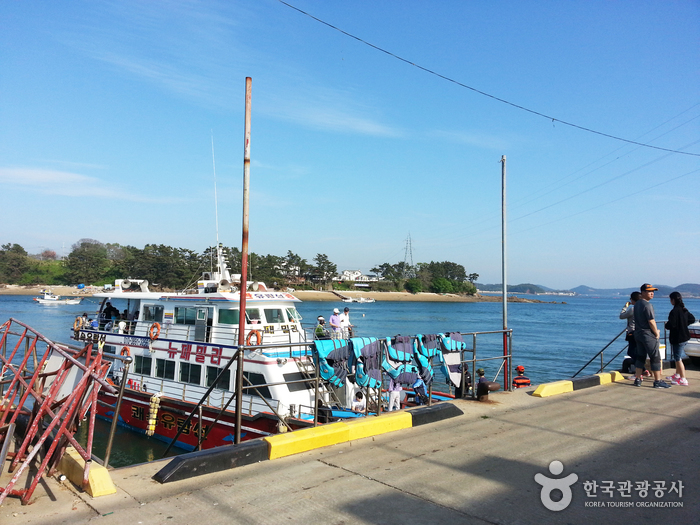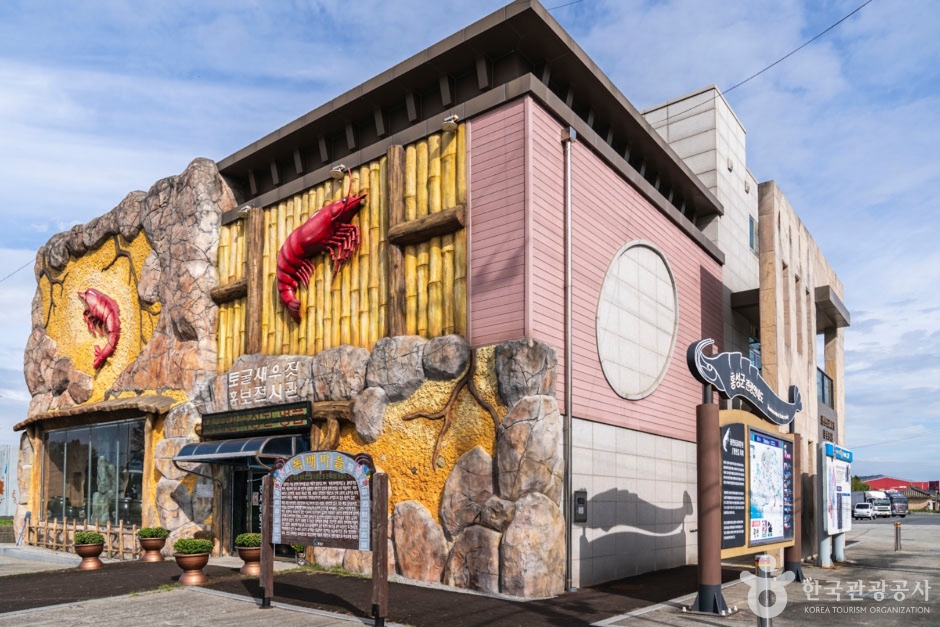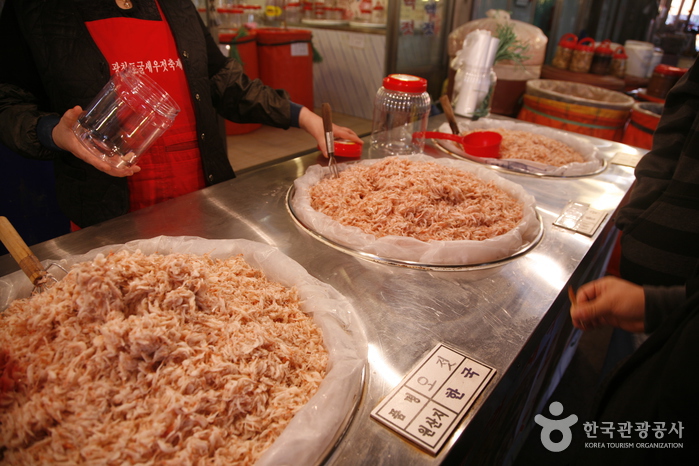Chungcheong Suyeongseong Fortress in Boryeong (보령 충청수영성)
.0M 2024-02-21
Chungcheongsuyeong-ro, Ocheon-myeon, Boryeong-si, Chungcheongnam-do
Chungcheong Suyeongseong Fortress in Boryeong is a stone fortress built by the Joseon dynasty (1392-1897) in the 16th century to defend against invasions through the Hwanghae Sea. It offers a picturesque view of the Hwanghae Sea and several islands. The entrance to the fortress, called Manghwamun Gate, showcases stone artistry with its polished granite arch. This site also has historical significance as a place where Catholic persecution occurred in the 19th century.
Ocheon Port (오천항)
199.7M 2024-02-21
Soseong-ri, Ocheon-myeon, Boryeong-si, Chungcheongnam-do
Ocheon Port is located in the northern part of Boryeong-si, where the Hwanghae Sea and Gwangcheoncheon Stream meet. It was once an important regional administrative center during the Joseon dynasty (1392-1897). Today, the port still retains its function, and visitors can explore and purchase various seafood caught in the Hwanghae Sea at the market. Ocheon Port Ferry Terminal operates ferry services to nearby islands such as Woldo Island and Yukdo Island.
Cheonbuk Green Barley Field (천북 청보리밭)
4.6Km 2025-07-21
Haman-ri, Cheonbuk-myeon, Boryeong-si, Chungcheongnam-do
Cheonbuk Green Barley Field in Boryeong has become a sought-after destination after gaining popularity on social media for its picture-perfect scenery. This beautiful lush green barley field was also featured in K-dramas, making it a favorite attraction for K-drama fans and travelers alike. Visitors are advised to be careful and not step on the barley while taking pictures. The entrance ticket comes with a drink coupon, redeemable at the café within the fields.
Seokhwachon (Boryeong) (석화촌(보령))
6.3Km 2024-02-26
15 Bakgangsul-gil, Jupo-myeon, Boryeong-si, Chungcheongnam-do
041-932-9005
Seokhwachon is a traditional Korean restaurant converted from a rural house. It specializes in Korean dishes. The menu includes specialties such as hanbang ori baeksuk (whole duck soup with medicinal herbs), hanbang dak baeksuk (whole chicken soup with medicinal herbs), samgyetang (ginseng chicken soup), saengseon gui (grilled fish), and galchi jorim (braised cutlassfish). The restaurant offers a variety of dishes that are both hearty and refined, combining sincerity and homemade flavors. Boasting a location where mountains and sea coexist, Boryeong offers diverse ingredients, and it hosts the Boryeong Mud Festival annually in July.
Gohyang Gul Susan (고향굴수산)
8.3Km 2024-03-04
8-5, 1061 Hongbo-ro, Cheonbuk-myeon, Boryeong-si, Chungcheongnam-do
041-641-8966
Gohyang Gul Susan is a restaurant specializing in oysters located within the Cheonbuk Oyster Complex. Oysters are the specialty of this place. Fresh oysters are paired with rice and vegetables harvested directly from the farm. The menu includes gul gui (grilled oysters), gul jjim (steamed oysters), gul jeon (pan-fried battered oyster), saeng gul (fresh oysters), dolsonn yeongyang gulbap (nutritious hot stone pot oyster rice), and gul kalguksu (noodle soup with oysters). Oysters are low in fat and rich in minerals, making them nutritious and flavorful. In December, the Cheonbuk Oyster Festival is held at the Cheonbuk Oyster Complex.
Cheonbuk Oyster Complex in Boryeong (보령 천북굴단지)
8.3Km 2024-06-05
Cheonbuk-myeon, Boryeong-si, Chungcheongnam-do
+82-41-930-0804
Cheonbuk Oyster Complex in Boryeong is a place near the Hongseong Embankment where various restaurants specializing in oysters are clustered. Boryeong is known for its abundant oyster production, with those caught between November and February considered the finest. In December, the Cheonbuk Oyster Festival is held, featuring events for tourists. Here, visitors can taste a variety of dishes made with oysters, including grilled oysters, raw oysters, and oyster rice.
Yeongmokhang Harbor (영목항)
9.6Km 2021-08-11
55, Wolgoji-gil, Taean-gun, Chungcheongnam-do
+82-41-673-9887
Yeongmokhang Harbor is located at the base of a small hill 4 kilometers away from Gonam-myeon, on the southern tip of Anmyeondo Island. The name was originally just Yeonghang Harbor but the name was changed to reflect its important role in connecting the areas of Boryeong and Taean. Across from the harbor are Wonsando, Hyojado, Chuseom, and Bbaeseom islands and ‘Three Brethren Rock.’ On the left are boats for Cheonsuman Bay. Fishing is the main industry in the region, which means that visitors can find plenty of fresh, quality seafood such as manila clams, conches, bass, and other types of seafood at low prices.
Gwangcheon Cave Salted Shrimp Complex (광천토굴새우젓단지)
9.7Km 2024-02-26
119, Gwangcheon-ro, Gwangcheon-eup, Hongseong-gun, Chungcheongnam-do
Gwangcheon Cave Salted Shrimp Complex is a collection of shops offering saeujeot (salted shrimp), a specialty of Gwangcheon. Gwangcheon’s proximity to the Yellow Sea makes it a famous place for jeotgal (salted seafood), particularly those made with shrimp. Gwangcheon’s saeujeot (salted shrimp) is stored and aged in a former mine cave tunnel, so it has great quality. There is even an exhibition hall dedicated to Gwangcheon cave salted shrimp. The Gwangcheon Cave Salted Shrimp & Dried Laver Festival is held in October.
Gwangcheon Cave Salted Shrimp Market (광천 토굴새우젓시장)
11.3Km 2024-02-26
8-20, Gwangcheon-ro 285beon-gil, Gwangcheon-eup, Hongseong-gun, Chungcheongnam-do
Gwangcheon Cave Salted Shrimp Market is a traditional market located in Gwangcheon, between Hongseong and Boryeong. Gwangcheon’s proximity to the Yellow Sea makes it a famous place for jeotgal (salted seafood), made using seafood and shrimp caught from the Yellow Sea, and laver seaweed. Gwangcheon’s saeujeot (salted shrimp) is stored and aged in a cave tunnel, so it has great quality. The market also offers agricultural goods, seafood, clothing, and sundry items.
Hongseong Jeongamsa Temple (정암사 (홍성))
11.5Km 2021-03-12
652, Oseo-gil, Hongseong-gun, Chungcheongnam-do
+82-41-641-0488
Jeongamsa Temple is a small rural temple situated halfway up Oseosan Mountain. There are few existing records that mention the temple’s beginning. Some suggest that it was built around AD 527 during the 5th year of Baekje King Seongwang’s reign, but there is little evidence to support this theory. The only reference alluding to a specific time is Yeojidoseo ("Detailed Survey of Korean Geography" published during the late Joseon dynasty). It states Jeongamsa Temple's location as on Oseosan Mountain, and Oseosan Mountain being surrounded by Hongsan Mountain and Baegwolsan Mountain and intersected by Hongju, Gyeolseong, and Boryeong. This indicates the temple was recognized in the mid-18th century and around the same time, Garamgo (a book about temples, published in the late 18th century) also states that Jeongamsa Temple is located approximately 11 kilometers to the east of Gyeolseonghyeon. It is still uncertain whether the temple referred to is Jeongamsa Temple on Oseosan Mountain.
Some foundation stones within the temple site measure 70-80 centimeters on each side. These stones indicate that the old Buddhist shrine of Jeongamsa Temple was laid out with five kan (Korean unit of measurement indicating the space between two pilars) at the front and three kan on the side. Future archaeological studies will help identify the true history of Jeongamsa Temple.




 English
English
 한국어
한국어 日本語
日本語 中文(简体)
中文(简体) Deutsch
Deutsch Français
Français Español
Español Русский
Русский